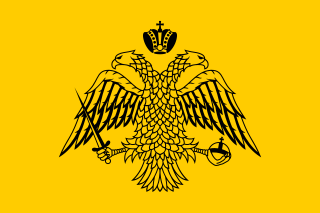Ecumenical Patriarchate of Constantinople
The Ecumenical Patriarchate of Constantinople (Greek: Οἰκουμενικόν Πατριαρχεῖον Κωνσταντινουπόλεως, romanized: Oikoumenikón Patriarkhíon Konstantinoupóleos, IPA: [ikumeniˈkon patriarˈçion konstandinuˈpoleos]; Latin: Patriarchatus Oecumenicus Constantinopolitanus;[3] Turkish: Rum Ortodoks Patrikhanesi,[4][5] "Roman Orthodox Patriarchate") is one of the fourteen to sixteen autocephalous churches (or "jurisdictions") that together compose the Eastern Orthodox Church. It is headed by the Ecumenical Patriarch of Constantinople, currently Bartholomew I, Archbishop of Constantinople.
| Ecumenical Patriarchate of Constantinople | |
|---|---|
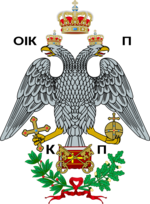 Coat of arms of the Ecumenical Patriarchate of Constantinople | |
| Classification | Eastern Orthodox |
| Orientation | Greek Orthodoxy |
| Scripture | Septuagint, New Testament |
| Theology | Eastern Orthodox theology |
| Polity | Episcopal |
| Primate | Archbishop of Constantinople-New Rome and Ecumenical Patriarch Bartholomew I |
| Bishops | 125 (73 acting, 52 titular) |
| Parishes | 525 in United States,[1] |
| Monastics | ~1,800 (Mt. Athos) |
| Monasteries | 20 (U.S)[1] 32 (Mt. Athos), 8 (Australia), 6 (Meteora) |
| Language | Greek, English, Ukrainian, French, Korean, Turkish |
| Headquarters | St. George's Cathedral, Istanbul 41°01′45″N 28°57′06″E |
| Territory | Istanbul, most of Turkey, Mount Athos, Crete, part of northern Greece, the Dodecanese, Korea, Greek and Ukrainian Orthodox Churches in the Diaspora |
| Founder | Apostle Andrew |
| Independence | 330 AD from the Metropolis of Heraclea |
| Separations | several, see § Present-day autocephalous churches previously under the Ecumenical Patriarchate Armenian Apostolic Church[2] |
| Members | ~3,800,000 in Greece, ~1,500,000 in diaspora, =5,300,000 in total . |
| Official website | ec-patr.org |
Because of its historical location as the capital of the former Eastern Roman (Byzantine) Empire and its role as the mother church of most modern Orthodox churches, Constantinople holds a special place of honor within Orthodoxy and serves as the seat for the Ecumenical Patriarch, who enjoys the status of primus inter pares (first among equals) among the world's Eastern Orthodox prelates and is regarded as the representative and spiritual leader of Orthodox Christians.[6][7][8][9][10][11]
The Ecumenical Patriarchate promotes the expansion of the Christian faith and Orthodox doctrine, and the Ecumenical Patriarchs are involved in ecumenism and interfaith dialogue, charitable work, and the defense of Orthodox Christian traditions. Prominent issues for the Ecumenical Patriarchate's policy in the 21st century include the safety of the believers in the Middle East, reconciliation of the Eastern Orthodox and Catholic Churches,[12] and the reopening of the Theological School of Halki, which was closed down by the Turkish authorities in 1971.[13][14]
History
The Great Church of Christ
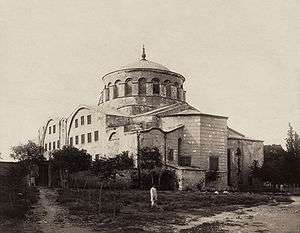
Christianity in the Greek colony of Byzantium existed from the 1st century, but it was in the year 330 that the Roman Emperor Constantine the Great moved his residence to the town renaming it Nova Roma (Νέα Ῥώμη), or "New Rome." Thenceforth, the importance of the church there grew, along with the influence of its bishop.
Prior to the moving of the imperial capital, the bishop of Byzantium had been under the authority of the metropolitan of Heraclea, but from the 4th century on, he grew to become independent in his own right and even to exercise authority throughout what is now Greece, Asia Minor, Pontus, and Thrace. With the development of the hierarchical structure of the Church, the bishop of Constantinople came to be styled as exarch (a position superior to metropolitan). Constantinople was recognized as the fourth patriarchate at the First Council of Constantinople in 381, after Antioch, Alexandria, and Rome. The patriarch was usually appointed by Antioch.
Because of the importance of the position of Constantinople's church at the center of the Roman Empire, affairs involving the various churches outside Constantinople's direct authority came to be discussed in the capital, particularly where the intervention of the emperor was desired. The patriarch naturally became a liaison between the emperor and bishops traveling to the capital, thus establishing the position of the patriarch as one involving the unity of the whole Church, particularly in the East.
In turn, the affairs of the Constantinopolitan church were overseen not just by the patriarch, but also by synods held including visiting bishops. This pan-Orthodox synod came to be referred to as the ενδημουσα συνοδος (endimousa synodos, "resident synod"). The resident synod not only governed the business of the patriarchate but also examined questions pertinent to the whole Church as well as the eastern half of the old empire.[15]
The patriarch thus came to have the title of Ecumenical, which referenced not a universal episcopacy over other bishops but rather the position of the patriarch as at the center of the oikoumeni, the "household" of the empire.
As the Roman Empire stabilized and grew, so did the influence of the patriarchate at its capital. This influence came to be enshrined in Orthodox canon law, to such an extent that it was elevated even beyond more ancient patriarchates: Canon 3 of the First Council of Constantinople (381) stated that the bishop of that city "shall have primacy of honor after the Bishop of Rome because Constantinople is the New Rome."
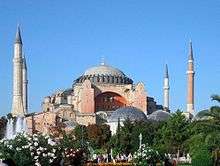
In its disputed 28th Canon, the Council of Chalcedon in 451 recognized an expansion of the boundaries of the Patriarchate of Constantinople and of its authority over bishops of dioceses "among the barbarians", which has been variously interpreted as referring either to areas outside the Byzantine Empire or to non-Greeks. The council resulted in a schism with the Patriarchate of Alexandria.
In any case, for almost a thousand years the Patriarch of Constantinople presided over the church in the Eastern Roman (Byzantine) Empire and its missionary activity that brought the Christian faith in its Byzantine form to many peoples north of the imperial borders. The cathedral church of Constantinople, Hagia Sophia (Holy Wisdom), was the center of religious life in the eastern Christian world.[16]
The Ecumenical Patriarchate came to be called the "Great Church of Christ" and it was the touchstone and reference point for ecclesiastical affairs in the East, whether in terms of church government, relations with the state, or liturgical matters.
Prerogatives of the Ecumenical Patriarchate
In history and in canonical literature (i.e. the Church's canons and traditional commentaries on them), the Ecumenical Patriarchate has been granted certain prerogatives (πρεσβεία, presveía) that other autocephalous Orthodox churches do not have. Not all of these prerogatives are today universally acknowledged, though all do have precedents in history and canonical references. The following is a (non-exhaustive) list of these prerogatives and their reference points:
- Equal prerogatives to Old Rome (Canon 28 of the Fourth Ecumenical Council, Canon 36 of the Quinisext Council);
- The right to hear appeals, if invited, regarding disputes between clergy (Canons 9 and 17 of the Fourth Ecumenical Council);
- The right to ordain bishops for areas outside defined canonical boundaries (Canon 28 of the Fourth Ecumenical Council);
- The right to establish stavropegial monasteries even in the territories of other patriarchates (the Epanagoge, commentaries of Matthew Blastares and Theodore Balsamon)
Iconoclast controversy
In the eighth and ninth centuries the iconoclast movement caused serious political unrest throughout the Empire. The emperor Leo III issued a decree in 726 against images and ordered the destruction of an image of Christ over one of the doors of the Chalke, an act which was fiercely resisted by the citizens.[17] Constantine V convoked a church council in 754, which condemned the worship of images, after which many treasures were broken, burned, or painted over with depictions of trees, birds or animals: one source refers to the church of the Holy Virgin at Blachernae as having been transformed into a "fruit store and aviary".[18] Following the death of his son Leo IV in 780, the empress Irene restored the veneration of images through the agency of the Second Council of Nicaea in 787.
The iconoclast controversy returned in the early 9th century, only to be resolved once more in 843 during the regency of Empress Theodora, who restored the icons. These controversies contributed to the deterioration of relations between the Western and the Eastern Churches.
Great Schism of 1054
The relations between the papacy and the Byzantine court were good in the years leading up to 1054. The emperor Constantine IX and the Pope Leo IX were allied through the mediation of the Lombard catepan of Italy, Argyrus, who had spent years in Constantinople, originally as a political prisoner.
Patriarch Michael I Cerularius ordered a letter to be written to the Bishop of Trani in which he attacked the "Judaistic" practices of the West, namely the use of unleavened bread. The letter was to be sent by John to all the bishops of the West, including the Pope. John promptly complied and the letter was passed to Humbert of Mourmoutiers, the cardinal-bishop of Silva Candida, who translated the letter into Latin and brought it to the Pope, who ordered a reply to be made to each charge and a defence of papal supremacy to be laid out in a response.
Although he was hot-headed, Michael was convinced to cool the debate and thus attempt to prevent the impending breach. However, Humbert and the pope made no concessions and the former was sent with legatine powers to the imperial capital to solve the questions raised once and for all. Humbert, Frederick of Lorraine, and Peter, Archbishop of Amalfi, arrived in April 1054 and were met with a hostile reception; they stormed out of the palace, leaving the papal response with Michael, who in turn was even more angered by their actions. The patriarch refused to recognise their authority or, practically, their existence.[19] When Pope Leo died on April 19, 1054, the legates' authority legally ceased, but they effectively ignored this technicality.[20]
In response to Michael's refusal to address the issues at hand, the legatine mission took the extreme measure of entering the church of the Hagia Sophia during the Divine Liturgy and placing a bull of excommunication on the altar.
The events of the East-West Schism are generally dated from the acts of 1054. However, these events only triggered the beginning of the schism. The full schism was not actually consummated by the seemingly mutual excommunications. The New Catholic Encyclopedia reports that the legates had been careful not to intimate that the bull of excommunication implied a general excommunication of the Byzantine Church. The bull excommunicated only Cerularius, Leo of Achrida, and their adherents. Thus, the New Catholic Encyclopedia argues that the dispute need not have produced a permanent schism any more than excommunication of any "contumacious bishop". The schism began to develop when all the other Eastern patriarchs supported Cerularius. According to the New Catholic Encyclopedia, it was the support of Emperor Michael VI Stratiotikos that impelled them to support Cerularius.[21] Some have questioned the validity of the bull on the grounds that Pope Leo IX had died at that time and so the authority of the legates to issue such a bull is unclear.[20]
The legates left for Rome two days after issuing the bull of excommunication, leaving behind a city near riot. The patriarch had the immense support of the people against the emperor, who had supported the legates to his own detriment. To assuage popular anger, the bull was burnt, and the legates were anathematised. Only the legates were anathematised and, in this case too, there was no explicit indication that the entire Western church was being anathematised.
In the bull of excommunication issued against Patriarch Michael I Cerularius by the papal legates, one of the reasons cited was the alleged deletion by the Eastern Church of the "Filioque" from the original Nicene Creed. In fact, it was precisely the opposite: the Eastern Church had not deleted anything; it was the Western Church that had added this phrase to the Nicene-Constantinopolitan Creed.[20]
As Bishop Kallistos Ware writes, "Even after 1054 friendly relations between East and West continued. The two parts of Christendom were not yet conscious of a great gulf of separation between them. […] The dispute remained something of which ordinary Christians in East and West were largely unaware".[22] In fact, efforts were made in subsequent centuries by Popes and Patriarchs to heal the rift between the churches. However, a number of factors and historical events worked to widen the separation over time.[23]
Fall of Constantinople in 1204 and the exile in Nicaea
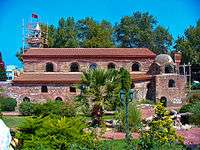
The Fourth Crusade in exchange for promised funds attempted to help the deposed emperor Alexius IV regain his throne. After taking Constantinople, returning Alexius IV to the throne, the revolt against and murder of Alexius IV left the Crusaders without payment. On 12 April 1204, the crusaders inflicted a severe sacking on Constantinople for three days, during which many ancient and medieval Roman and Greek works were either stolen or destroyed. Despite their oaths and the threat of excommunication, the Crusaders ruthlessly and systematically violated the city's holy sanctuaries, destroying, defiling, or stealing all they could lay hands on; nothing was spared. It was said that the total amount looted from Constantinople was about 900,000 silver marks. The Venetians received 150,000 silver marks that was their due, while the Crusaders received 50,000 silver marks. A further 100,000 silver marks were divided evenly up between the Crusaders and Venetians. The remaining 500,000 silver marks were secretly kept back by many Crusader knights.
Nicetas Choniates gives a vivid account of the sack of Constantinople by the Frankish and Venetian Crusaders of the Fourth Crusade:
The Latin soldiery subjected the greatest city in Europe to an indescribable sack. For three days they murdered, raped, looted and destroyed on a scale which even the ancient Vandals and Goths would have found unbelievable. Constantinople had become a veritable museum of ancient and Byzantine art, an emporium of such incredible wealth that the Latins were astounded at the riches they found. Though the Venetians had an appreciation for the art which they discovered (they were themselves semi-Byzantines) and saved much of it, the French and others destroyed indiscriminately, halting to refresh themselves with wine, violation of nuns, and murder of Orthodox clerics. The Crusaders vented their hatred for the Greeks most spectacularly in the desecration of the greatest Church in Christendom. They smashed the silver iconostasis, the icons and the holy books of Hagia Sophia, and seated upon the patriarchal throne a whore who sang coarse songs as they drank wine from the Church's holy vessels. The estrangement of East and West, which had proceeded over the centuries, culminated in the horrible massacre that accompanied the conquest of Constantinople. The Greeks were convinced that even the Turks, had they taken the city, would not have been as cruel as the Latin Christians. The defeat of Byzantium, already in a state of decline, accelerated political degeneration so that the Byzantines eventually became an easy prey to the Turks. The Crusading movement thus resulted, ultimately, in the victory of Islam, a result which was of course the exact opposite of its original intention.[24]
During this era, Roman Catholic-Orthodox relations were at their lowest point, and the retaliation during the Massacre of the Latins would make the severed ties from the Great Schism permanent—dividing Christianity on a level that would be unseen until the Protestant Reformation.[25]
When Pope Innocent III heard of the conduct of his pilgrims, he was filled with shame and strongly rebuked the crusaders.
Meanwhile, the Latin Empire of Constantinople was established, and Byzantine refugees founded their own successor states, the most notable of these being the Empire of Nicaea under Theodore Lascaris (a relative of Alexius III), the Empire of Trebizond, and the Despotate of Epirus.
The new seat of the Patriarchate was established in the city of Nicaea until in 1261, when Constantinople was reconquered by the Byzantine Emperor Michael VIII Palaiologos.
Fall of Constantinople in 1453 and Ottoman period
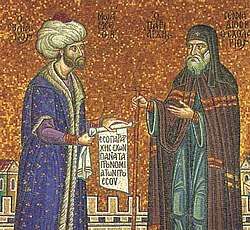
After Constantinople was overrun by the Ottoman Turks in 1453, the Patriarchate came to care more directly for all the Orthodox living in the Ottoman Empire. Mehmed II appointed Gennadios II Scholarios as the Patriarch in 1454 and designated him as the spiritual leader as well as the ethnarch or, in Turkish, milletbashi of all the Orthodox Christians in the Empire, regardless of ethnic origin; not only Greeks, but also Bulgarians, Serbs, Albanians, Wallachians, Moldavians, Croatis, Syrians, orthodox Arabs, Georgians and Lazs came under the spiritual, administrative,[26] fiscal, cultural and legal[26] jurisdiction of the Patriarchate.[27] Some of the other patriarchs came at various points to live permanently in Constantinople and function as part of the local church government. This situation, according to some of the Orientalists and historians, shows the Pax Ottomana (or Pax Ottomanica, literally "the Ottoman Peace").
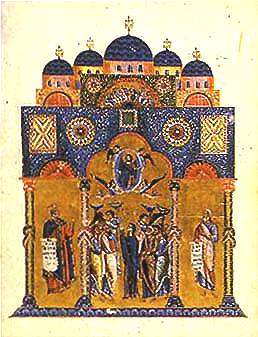
The Russian Orthodox Church, which for centuries had been a diocese of the Ecumenical Patriarchate, declared its independence in 1448 shortly before Constantinople fell owing to its protest over the Council of Florence, in which representatives of the patriarchate had signed onto union with Rome, trading doctrinal concessions for military aid against the encroaching Ottomans. The military aid never came and those concessions were subsequently repudiated by the patriarchate but, from 1448, the Russian church came to function independently. Within decades after the Fall of Constantinople to Mehmed II of the Ottoman Empire on 29 May 1453, some were nominating Moscow as the "Third Rome", or the "New Rome". In 1589, 141 years later, Constantinople came to recognize Russia's independence and led the Orthodox Church in declaring Russia also to be a patriarchate, numbering Moscow's bishop as fifth in rank behind the ancient patriarchates. The Russian Orthodox Church became the largest of the Eastern Orthodox churches in the world.
As Ottoman rule weakened, various parts of the Orthodox Church that had been under the direct influence of the Ecumenical Patriarchate came to be independent. These churches at first usually declared their independence without universal approval, which came after Constantinople gave its blessing. The rate at which these new autocephalous ("self-headed") churches came into being increased in the 19th century, particularly with the independence of Greece.
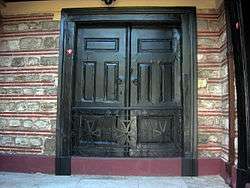
In 1833, the Church of Greece declared its autocephaly, which was subsequently recognized by the patriarchate in 1850. In 1865, the Romanian Orthodox Church, against the protests of Constantinople, declared its independence, which was acknowledged in 1885. A year before Greece's autocephaly was self-proclaimed, the Serbian Orthodox Church was named autocephalous by the local secular government but Constantinople refused recognition until 1879. In 1860 the Bulgarians de facto seceded from the Great Church; in 1870 the Bulgarian church was politically recognized as autonomous under the name Bulgarian Exarchate by the Sultan's firman, but it was not until 1945 that it was recognized by the Ecumenical Patriarchate. In 1922, the Albanian Orthodox Church declared its autocephaly, being granted recognition of it in 1937.
In addition to these churches, whose territory had been agreed upon by all as within Constantinople's jurisdiction, several other disputed areas' Orthodox churches have had recognition by the Ecumenical Patriarchate as either autocephalous or autonomous, including the Finnish Orthodox Church and Estonian Orthodox Church in 1923, the Polish Orthodox Church in 1924, and the Czech and Slovak Orthodox Church in 1998. The majority of these disputes are a result of the expansion of the Russian Empire, which often included a subjugation of the Orthodox churches in conquered lands to the Moscow Patriarchate. Due to this, the Moscow Patriarchate often disputes the Ecumenical Patriarch's role as prime representative and spiritual leader of the world's Orthodox Christians, citing that it represents the numerically largest Orthodox community.[28]
Ecclesiastical buildings in Ottoman cities
As a ruling institution, the Ottoman Empire brought regulations on how the cities would be built (quality reassurances) and how the architecture (structural integrity, social needs, etc.) should be shaped. Special restrictions were imposed concerning the construction, renovation, size and usage of bells in churches. For example, in a town a church should not be larger in size than the largest mosque. Some churches were destroyed (e.g. the Church of the Holy Apostles), many were converted into mosques (among them the Hagia Sophia and Chora Church in Constantinople, and the Rotunda and Hagios Demetrios in Thessaloniki) or served for other uses (e.g. Hagia Irene in Constantinople, which became an armory for the Janissaries, and the Gül Mosque [Hagia Theodosia or Christ Euergetes], also in Constantinople, which after the Conquest served for a while as a naval dockyard). Such rules, however, although very strict in the beginning, with time and the increasing importance in the Ottoman Empire of the Rûm Millet were more and more disregarded, so that in the 19th century in Istanbul there was a veritable building boom of Orthodox churches, many among them having high bell towers and brick domes, both of which had previously been strictly prohibited.
Patriarchate under the secular Republic of Turkey
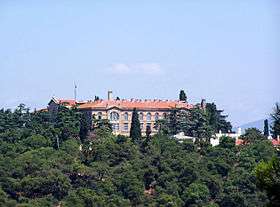
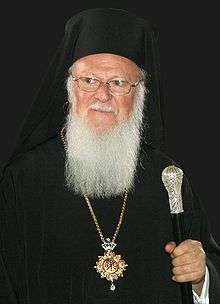
Since 1586 the Ecumenical Patriarchate has had its headquarters in the relatively modest Church of St George in the Fener (Phanar) district of Istanbul. The current territory of the Patriarchate is significantly reduced from what it was at its height. Its canonical territory currently includes most of modern Turkey, northern Greece and Mount Athos, the Dodecanese and Crete. By its interpretation of Canon 28 of Chalcedon, Constantinople also claims jurisdiction over all areas outside the canonically defined territories of other Orthodox churches, which includes the entire Western hemisphere, Oceania, the United Kingdom, Western Europe, Northeast Asia, Southeast Asia. This claim is disputed by other autocephalous churches with dioceses in those areas, as well as the Turkish government.
The Orthodox presence in Turkey itself is small; however the majority of Orthodox in North America (about two-thirds) are under the Ecumenical Patriarchate, primarily in the Greek Orthodox Archdiocese of America.[29] The Patriarchate also enjoys an even greater majority in the United Kingdom. Furthermore, the Albanian, Rusyn and Ukrainian jurisdictions in America are also part of the Patriarchate.
Most of the Patriarchate's funding does not come directly from its member churches but rather from the government of Greece, due to an arrangement whereby the Patriarchate had transferred property it had owned to Greece. In exchange, the employees, including the clergy, of the Patriarchate are remunerated by the Greek government. The Greek Orthodox Archdiocese of America provides substantial support through an annual contribution, known as the logia, and its institutions, including the American-based Greek Orthodox Ladies Philoptochos Society and the Archons of the Ecumenical Patriarchate, usually important laymen who make large donations for the upkeep of the Patriarchate. In turn, they are granted honorary titles which once belonged to members of the Patriarchal staff in centuries past.
The Patriarchate acts in the capacity of being an intermediary and facilitator between the Orthodox churches and also in relations with other Christians and religions. This role sometimes brings the Patriarchate into conflict with other Orthodox churches, as its role in the Church is debated. The question centers around whether the Ecumenical Patriarchate is simply the most honored among the Orthodox churches or whether it has any real authority or prerogatives (πρεσβεία, presveía) that differ from the other autocephalous churches. This dispute is often between Constantinople and Moscow, the largest Orthodox church in terms of population, especially as expressed in the Third Rome theory which places Moscow in the place of Constantinople as the center of world Orthodoxy. Such disputes sometimes result in temporary breaks in full communion, though usually not for very long.
The relationship between Constantinople and the Ottoman Empire was frequently bitter, due in no small part to the privilege given to Islam. In the secular Republic of Turkey, tensions are still constant. Turkey requires by law that the Patriarch be a Turkish citizen by birth, which all Patriarchs have been since 1923—all ethnic Greeks from the minuscule and steadily decreasing Greek minority of Turkey, which is causing a shortage of priests and consequently potential candidates for the post of Ecumenical Patriarch.[30] The state's expropriation of church property and the closing of the Orthodox Theological School of Halki are also difficulties faced by the Patriarchate.
Administration and structure
Holy Synod
The affairs of the patriarchate are conducted by the Holy Synod, presided over by the Ecumenical Patriarch. The synod has existed since some time prior to the fourth century and assists the patriarch in determining the affairs of the possessions under his jurisdiction. The synod first developed from what was referred to as the resident synod, composed of the patriarch, local bishops, and any Orthodox bishops who were visiting in the imperial capital of Constantinople. After the fall of Constantinople, the synod's membership became limited to bishops of the patriarchate.
The Holy and Sacred Synod, presided over by His All-Holiness Ecumenical Patriarch BARTHOLOMEW, is composed of twelve Hierarchs, each serving a year-long term, with half of the Synod's members changing every six months in March and September.
The current members of the Holy and Sacred Synod serving from March 1, 2019 – August 31, 2019, are as follows:
- Augustinos of Germany
- Germanos of Tranoupolis
- Sotirios of Toronto
- Makarios of Aneon
- Theodoretos of Laodicea
- Eugenios of Rethymno and Avlopotamos
- Amphilochios of Ganou and Chora
- Damaskinos of Kydonia and Apokoronos
- Nathanael of Kos and Nisyros
- Constantine of Singapore
- Chrysostomos of Symi
- Nathanael of Chicago
Notable hierarchs of the Ecumenical Patriarchate are the popular writer Kallistos (Timothy) Ware, an assistant-bishop in the Archdiocese of Thyateira and author of The Orthodox Church, the best-known introduction to the Orthodox Church in English, and John Zizioulas, Metropolitan of Pergamon, a well-known professor of Systematic Theology.
The right of non-Turkish members of the synod (from Northern Greece, the Dodecanese, America and Western Europe) to convene appears to be threatened by a recent declaration from the Istanbul Governor reported in the Freiburg archdiocesan magazine.[31]
Structure
.svg.png)
Head of the Patriarchate of Constantinople and of the Holy Synod is the Archbishop of Constantinople, New Rome and Ecumenical Patriarch and Co-Head of State of Mount Athos, who since 1991 has been Bartholomew I (Dimítrios Archontónis). The local churches of the Ecumenical Patriarchate consist of six archdioceses, 66 metropolises, 2 dioceses and one exarchate, each of which reports directly to the Patriarch of Constantinople with no intervening authority.
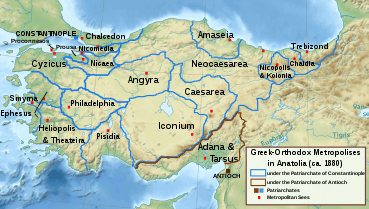
Archdioceses and Archbishops
- Archdiocese of Constantinople and New Rome (Patriarchal archdiocese):
- Metropolis of Chalcedon: Athanasios Papas (2008–)[32]
- Metropolis of Derkoi: Apostolos Daniilidis (2011–)[32]
- Metropolis of Imbros and Tenedos: Cyril Dragounis (2002–2020), Cyril Sykis (2020-)[32]
- Metropolis of the Prince's Islands: Iakovos Sofroniadis (2002–)[32]
- Metropolis of Pisidia: Sotirios of Pisidia[32]
- Metropolis of Prusa: Vacant since May 11, 2019
- Metropolis of Smyrna: Bartholomew Samaras (2016–)[32]
- Metropolis of Adrianopolis: Amfilochios of Adrianoupolis[32]
- Metropolis of Karpathos and Kasos: Ambrosios Panagiotidis (1983–)[33]
- Metropolis of Kos and Nisyros: Nathaniel II (Philippos) Diakopanagiotis (2009–)[33]
- Metropolis of Leros, Kalymnos and Astypalaia and Exarchate of the Southern Sporades: Païsios (Panagiotis) Aravantinos (2005–)[33]
- Metropolis of Rhodes: Cyril II (Konstantinos) Kogerakis (2004–)[33]
- Metropolis of Syme: Chrysostomos (Ioannis) Dimitriadis (2004–)[33]
- Exarchate of Patmos: Antipas Nikitaras (2000–)[33]
Spiritually assigned to the Ecumenical Patriarchate by the Patriarchal and Synodic Act of 4 September 1928:
- Metropolis of Alexandroupolis Anthimos Koukouridis (2004–)
- Metropolis of Chios, Psara and Inousses: Markos Basilakis (2011–)
- Metropolis of Didymoteichon and Orestias: Damaskinos (Minas) Karpathakis (1995–)
- Metropolis of Drama: Paulos (Alexandros) Apostolidis (2005–)
- Metropolis of Dryinoupolis, Pogoniani and Konitsa: Andreas Trempelas (1995–)
- Metropolis of Edessa, Pella and Almopia: Joel (Panagiotis) Phrankakos (2002–)
- Metropolis of Elassona: Baselios Kolokas (1995–)
- Metropolis of Eleftheroupolis: Chrysostomos Abagianos (2004–)
- Metropolis of Florina, Prespes and Eordaia: Theoklitos (Thomas) Passalis (2000–)
- Metropolis of Goumenissa, Axioupoli and Polykastro: Dimitrios Bekiaris (1989–)
- Metropolis of Grevena: Sergios Sigalas (1976–)
- Metropolis of Ierissos, Mount Athos and Ardameri: Theoklitos Athanasopoulos (2012–)
- Metropolis of Ioannina: Theoklitos Setakis (1975–)
- Metropolis of Kassandria: Nikodemos (Konstatinos) Korakis (2001–)
- Metropolis of Kastoria: Seraphim (Ioannis) Papakostas (1996–)
- Metropolis of Kitros, Katerini and Platamonas: Agathonikos (Georgios) Nikolaou (1985–)
- Metropolis of Langadas, Liti and Rentina: Ioannis Tassias (2010–)
- Metropolis of Lemnos and Agios Efstratios: Hierotheos Garyphallos (1988–)
- Metropolis of Maronia and Komotini: Damaskinos Roumeliotis (1974–)
- Metropolis of Mithymna: Chrysostomos Kalamatianos (1984–)
- Metropolis of Mytilini, Eresos and Plomari: Iakobos Kleombrotos (1988–)
- Metropolis of Neapolis and Stavroupolis: Barnabas Tyris (2004–)
- Metropolis of Nea Krini and Kalamaria: Prokopios Georgantopoulos (1974–)
- Metropolis of Nea Zichni and Nevrokopion: Hierotheos (Dimitrios) Tsoliakos (2003–)
- Metropolis of Nikopolis and Preveza: Meletios Kalamaras (1980–)
- Metropolis of Paramythia, Filiates, Giromeri and Parga: Titos (Sotirios) Papanakos (1974–)
- Metropolis of Philippi, Neapolis and Thasos: Prokopios Tsakoumakas (1974–)
- Metropolis of Polyani and Kilkis: Emmanuel Sigalas (2009–)
- Metropolis of Samos and Ikaria: Eusebios (Evangelos) Pistolis (1995–)
- Metropolis of Serres and Nigrita: Theologos (Ioannis) Apostolidis (2001–)
- Metropolis of Servia and Kozani: Paulos Papalexiou (2004–)
- Metropolis of Siderokastron: Makarios (Sotirios) Philotheou (2001–)
- Metropolis of Sisanion and Siatista: Paulos (2006–)
- Metropolis of Thessaloniki: Anthimos (Dionysios) Roussas (1974–)
- Metropolis of Veria and Naousa: Panteleimon (Ioannis) Kalpakidis (1994–)
- Metropolis of Xanthi and Peritheorion: Panteleimon (Mikhael) Kalaphatis (1995–)
- Archdiocese of Crete (Heraklion): Eirinaios Athanasiadis (2006–)
- Metropolis of Gortyna and Arkadia and Exarchate of Middle Crete: Makarios Douloufakis (2005–)
- Metropolis of Rethymnon and Avlopotamos and Exarchate of Upper Crete: Evgenios (Evangelos) Antonopoulos (2010); former bishop of the Diocese of Knossos
- Metropolis of Kydonia and Apokoronos: Damaskinos Papagiannakis (2006–)
- Metropolis of Lampi, Syvritos, and Sfakia: Eirinaios (Nikolaos) Mesarchakis (1990–)
- Metropolis of Ierapytna and Siteia and Exarchate of Eastern Crete: Evgenios (Michael) Politis (1994–)
- Metropolis of Petra and Cherronisos: Nektarios Papadakis (1990–2015), Gerasimos (2015–)
- Metropolis of Kissamos and Selino: Amphilochios Andronikakis (2005–)
- Metropolis of Arkalochorion, Kastelion and Viannos: Andreas Nanakis (2001–)
- Archdiocese of Canada: Sotirios Athanasoulas (1979–)
- Archdiocese of Italy and Melite and Exarchate of Southern Europe (Venice): Gennadios (Tsabikos) Zervos (1996–)
- Archdiocese of Thyateira and Great Britain (London, includes the UK, Ireland and the Crown dependencies): Nikitas Loulias (2019–)
- Archdiocese of Australia (Sydney): Makarios Griniezakis (2019–)
- Archdiocese of America and Exarchate of the Atlantic and Pacific Oceans (headquartered in New York City): Elpidoforos Lampriniadis (2019–)
- Metropolis of Chicago: Nathanael Symeonides (2018–)
- Metropolis of New Jersey: Evangelos Kourounis (2003–)
- Metropolis of Atlanta: Alexios Panagiotopoulos (1999–)
- Metropolis of Denver: Isaiah Chronopoulos (1992–)
- Metropolis of Pittsburgh: Savas Zembillas (2012–)
- Metropolis of Boston: Methodios (Georgios) Tournas (1984–)
- Metropolis of Detroit: Nicholas Pissaris (1999–)
- Metropolis of San Francisco: Gerasimos Michaleas (2005–)
Metropolises and Metropolitans
- Metropolis of Austria and Exarchate of Hungary and Middle Europe (Vienna): Arsenios Kardamakis (2011–)
- Metropolis of Belgium and Netherlands and Exarchate of the Low Countries and Luxembourg (Brussels): Athenagoras (Yve) Peckstadt (2013–)
- Metropolis of France (Paris): Emmanuel Adamakis (2003–)
- Metropolis of Germany (Bonn): Augustinos Labardakis (1980–)
- Metropolis of Sweden and all Scandinavia and Exarchate of the Northern Countries (Stockholm): Cleopas Strongylis (2014–)
- Metropolis of Spain and Portugal (Madrid): Polycarpos (Panagiotis) Stavropoulos (2007–)
- Metropolis of Switzerland (Chambésy, Geneva): Ieremias (Paraschos) Kalligiorgis (2003–)
- Metropolis of Buenos Aires and Exarchate of All South America: Tarasios (Petros) Antonopoulos (2001–)
- Metropolis of Mexico and Exarchate of All Central America and the Caribbean: Athenagoras (Georgios) Anastasiadis (1996–)
- Metropolis of Hong Kong and Southeast Asia and Exarchate of the Philippines: Nektarios (Tsilis) (2008–)
- Metropolis of Korea and Exarchate of All the Upper East (Seoul): Ambrosios (Aristotelis) Zografos (2008–)
- Metropolis of New Zealand and Exarchate of All Oceania (Wellington): Myron Ktistakis (2018-)
- Metropolis of Singapore and South Asia: Konstantinos Tsilis (2011–)
- Metropolis of Central Canada (Ukrainian Orthodox Church of Canada): Yurij (Kalistchuk) (2010–)
- Diocese of Eastern Canada: Vacant (Administrator: Bishop Andrew (Peshko) of Krateia)
- Diocese of Western Canada: Hilarion (Rudnyk) (2008–)
- Metropolis of Western Europe (Ukrainian Orthodox Church): John Derevianka (1991–)
- Diocese of London: Andrea (Theodosios) Pesko (2005–)
- Metropolis of Eastern Eparchy (Ukrainian Orthodox Church of the USA): Antonios Scharba (1995–)
- Diocese of Western Eparchy (Chicago): Pamphylos Daniel Zelinsky (2009–)
Dioceses and Bishops
- Diocese of America (Albanian Orthodox church): Philomelion Elias Katre (2002–)
- Diocese of North America (American Carpatho-Russian Orthodox church): Nyssa Gregory (Tatsis) (2012–)
Titular archdioceses
- Archdiocese of Komana and All Cappadocia: Gabriel (Guido) De Vylder (2003–2013)
- Archdiocese of Hierapolis: Antonios Sarba (1995–present)
- Archdiocese of Thyatira: Nikitas Loulias (2019–present)
Titular metropolises
- Metropolis of Caesarea: Vacant
- Metropolis of Ephesus: Vacant
- Metropolis of Heraclea and Exarchate of Thrace: Vacant
- Metropolis of Cyzicus: Vacant
- Metropolis of Nicomedia: Joachim (Elias) Nerantzoulis (2008–); former metropolitan of Chalcedon
- Metropolis of Nicaea and Exarchate of Bithynia: John V Rinne (2001–2010; former archbishop of Karelia and all Finland); Constantinos Charisiadis (2011–)
- Metropolis of Aenos: Vacant
- Metropolis of Amasya and Exarchate of All Euxinous Pontus: Vacant
- Metropolis of Hadrianopolis: Damaskinos Papandreou (2003-2014); former metropolitan of Switzerland; Amphilochios Stergiou (2014–)
- Metropolis of Anea: Vacant
- Metropolis of Ankyra and Exarchate of All Galatia: Vacant
- Metropolis of Augustopolis: Vacant
- Metropolis of Chaldia, Cheriana and Kerasous and Exarchate of Helenopontus: Vacant
- Metropolis of Crine and Exarchate of Ionia: Vacant
- Metropolis of Cydonies: Vacant
- Metropolis of the Dardanelles and Exarchate of All Hellespontus: Nikitas Loulias (2007-2019); former metropolitan of Hong Kong and East Asia
- Metropolis of Eucarpia: Vacant
- Metropolis of Euchaita: Vacant
- Metropolis of Eudoxias: Vacant
- Metropolis of Ganos and Chora and All the Thracian Coast: Amphilochios Tsoukos (2018– )
- Metropolis of Helioupolis and Theira and Exarchate of All Caria: Chrysostomos Mavroyiannopoulos (2019 –)
- Metropolis of Helenopolis: Vacant
- Metropolis of Kolonia: Vacant
- Metropolis of Iconium and Exarchate of Lycaonia: Theoleptos (Jacob) Fenerlis (2000–)
- Metropolis of Kallipolis and Madytos: Stephanos Ntinidis (2011–)
- Metropolis of Laodicea and Exarchate of Phrygia: Vacant
- Metropolis of Lititsa: Vacant
- Metropolis of Lystra: Kallinicos (Symeon) Alexandridis (1985–); former metropolitan of Prince's Islands
- Metropolis of Metres and Athyra: Vacant
- Metropolis of Melitene: Vacant
- Metropolis of Miletus: Apostolos Voulgaris (1990–)
- Metropolis of Moschonisia and Exarchate of Aeolis: Apostolos Daniilidis (2000–2011)
- Metropolis of Myra: Chrysostomos Kalaitzis (1995–)
- Metropolis of Myriophyton and Peristasis: Irinaios Ioannidis (2000–)
- Metropolis of Neocaesaria and Exarchate of Pontus Polemoniacus: Vacant
- Metropolis of Pergamon and Adramyttion: John II Zizioulas (1986–)
- Metropolis of Perge and Exarchate of Pamphylia: Evangelos Galanis (1970–)
- Metropolis of Philadelphia and Exarchate of Lydia: Meliton (Dimitrios) Karras (1990–)
- Metropolis of Pisidia and Exarchate of Side, Myra and Attalia: Sotirios Trambas (2008–); former metropolitan of Korea and Japan
- Metropolis of Prokonnesos and Exarchate of All Propontis: Joseph (Emmanuel) Charkiolakis (2008–); former metropolitan of New Zealand
- Metropolis of Prousa: Elpidiphoros Lambriniadis (2011–)
- Metropolis of Rhodopolis: Vacant
- Metropolis of Saranta Ecclesies: Vacant
- Metropolis of Sardis: Vacant
- Metropolis of Sasima and Cappadocia Secunda: Gennadios Lymouris (1997–)
- Metropolis of Sebasteia and Exarchate of All Paphlagonia: Dimitrios Kommatas (1990–)
- Metropolis of Seleucia and Pamphylia: Vacant
- Metropolis of Silyvria: Maximos Vgenopoulos (2014–)
- Metropolis of Smyrna and Exarchate of All Asia Minor: Bartholomeos Samaras (2016–)
- Metropolis of Traianopolis: Germanos Chaviaropoulos (1987–)
- Metropolis of Trapezous and Exarchate of Lazica: Vacant
- Metropolis of Troas: Vacant
- Metropolis of Tyana: Païsios (Emmanuel) Loulourgas (1998–)
- Metropolis of Tyroloi and Serention: Panteleimon (Evangelos) Rhodopoulos (1977–)
- Metropolis of Bizye and Medea: Vacant
- Metropolis of Vryoula and Erythrae: Epiphanios (Konstantinos) Perialas (2007–); former metropolitan of Spain and Portugal
Titular dioceses
- Diocese of Abydos: Kyrillos Katerelos (2008–)
- Diocese of Amorion: Ioannis Kalogerakis (1992–)
- Diocese of Andidon: Christophoros Rakintzakis (1999–)
- Diocese of Apamea: Vikentios (Vasileios) Malamatenios (1998–)
- Diocese of Arianzos: Vartholomeos (Ioannis) Kessidis (2004–)
- Diocese of Ariste: Vasileios Tsiopanas (1976–)
- Diocese of Aspendos: Jeremy Ferens (1995–)
- Diocese of Claudiopolis: Michael Storochenko (1995–)
- Diocese of Christoupolis: Vacancy
- Diocese of Dioclea: Kallistos Ware (1982–)
- Diocese of Dorylaeum: Nikandros (Nikolaos) Palybos (2001–)
- Diocese of Eumeneia: Maximos (Ioannis) Mastihis (1977–)
- Diocese of Halicarnassus: Emmanuel Alevrofas (2005–2010)
- Diocese of Irenopolis: Konstantinos Buggan (1995–)
- Diocese of Kratea: Andrea (Theodosios) Pesko (2005–)
- Diocese of Lampsacus: Makarios (Pavlos) Pavlidis (1985–)
- Diocese of Lefki: Eumenios Tamiolakis (1994–)
- Diocese of Meloa: Philotheos
- Diocese of Mokissus: Dimitrios Katzavelos (2006–)
- Diocese of Olympos: Anthimos Drakonakis (1992)
- Diocese of Pamphylos: Daniel Zelinsky (2008–)
- Diocese of Parnassus: John Derevianka (1995–)
- Diocese of Phasiane: Antonios Paropoulos (2002–)
- Diocese of Philomelion: Elias Katre (2002–)
- Diocese of Sinope:
- Diocese of Synnada: Dionysios (Charalampos) Sakatis (1996–)
- Diocese of Telmessos: Ilarion (Roman) Rudnyk (2008–)
- Diocese of Theoupolis: Panteleimon Sklavos (1972–)
- Diocese of Troas: Savvas Zembilas (2002-2012)
- Diocese of Tropaeon: Athanasios Theocharous (1997–)
- Diocese of Zelon: Sevastianos (2012–)
Historical Archdioceses
- Archdiocese of Syracuse
- Archdiocese of Russian Orthodox churches in Western Europe—Exarchate for Orthodox Parishes of Russian Tradition in Western Europe (Paris) (disestablished 2018)
Historical Metropolises
- Metropolis of Anchialos
- Metropolis of Balgrad, one of founding archdioceses of Romanian Orthodox Church
- Metropolis of Calabria
- Metropolis of Devròn and Velissus, under jurisdiction of the Ecumenical Patriarchate from 1767 to 1920
- Metropolis of Gothia and Caffa (liquidated by the Russian Orthodox Church in 1779, see Annexation of Crimea by the Russian Empire)
- Metropolis of Kamianets[34] (Podolia Eyalet)
- Metropolis of Kiev, Halych, and all Ruthenia—Exarchate of Ukraine (1620–1686), Patriarch Dionysius IV of Constantinople sold it to Moscow Patriarchate for 200 chervonetsi and 120 sables[35]
- Metropolis of Kiev (988–1596), Union of Brest
- Metropolis of Kolonia
- Metropolis of Halych (1303–1347), succeeded and reintegrated back into Metropolis of Kiev
- Metropolis of Lithuania (1317–1435), succeeded and reintegrated back into Metropolis of Kiev
- Metropolis of Miletopolis: Iakobos Kogarah (2011–)
- Metropolis of Melenikon
- Metropolis of Moldo-Wallachia (Metropolis of Moldavia and Bukovina), one of founding archdioceses of Romanian Orthodox Church
- Metropolis of Monastirion and Pelagonia, under jurisdiction of the Ecumenical Patriarchate from 1767 to 1920
- Metropolis of Nevrokopion
- Metropolis of Philippopolis
- Metropolis of Prèspes and Achrida, under jurisdiction of the Ecumenical Patriarchate from 1767 to 1920
- Metropolis of Proilaviei (Ottoman Ukraine)
- Metropolis of Raskopresrèna, under jurisdiction of the Ecumenical Patriarchate from 1766 to 1920
- Metropolis of Riga and All Latvia
- Metropolis of Skopia, under jurisdiction of the Ecumenical Patriarchate from 1766 to 1920
- Metropolis of Sozopolis (and later Sozoagathopolis)
- Metropolis of Stromnitsa, under jurisdiction of the Ecumenical Patriarchate from 1767 to 1920
- Metropolis of Ugro-Wallachia (Metropolis of Muntenia and Dobrudja), one of founding archdioceses of Romanian Orthodox Church
- Metropolis of Vanialuka, under jurisdiction of the Ecumenical Patriarchate from 1900 to 1920
- Metropolis of Varna
- Metropolis of Vellègradon, under jurisdiction of the Ecumenical Patriarchate from 1766 to 1879
- Metropolis of Nissa, under jurisdiction of the Ecumenical Patriarchate from 1766 to 1879
- Metropolis of Vosna, under jurisdiction of the Ecumenical Patriarchate from 1766 to 1920
- Metropolis of Svornikion, under jurisdiction of the Ecumenical Patriarchate from 1766 to 1920
Historical Dioceses
- Diocese of Agia and Sykourion
- Diocese of Agrafa and Litza
- Diocese of Amphipolis
- Diocese of Amylcae
- Diocese of Christianoupolis
- Diocese of Angon
- Diocese of Argyropolis
- Diocese of Agathopolis
- Diocese of Agathonicea
- Diocese of Katania
- Diocese of Konstantia
- Diocese of Daphnusia
- Diocese of Dodona
- Diocese of Elaea
- Diocese of Kampania
- Diocese of Meloe
- Diocese of Messene
- Diocese of Myrina
- Diocese of Nyssa
- Diocese of Petra
- Diocese of Platamon and Lykostomion
- Diocese of Ravenna
- Diocese of Skopelos
- Diocese of Talantion
- Diocese of Thermia and Kea
- Diocese of Trachaea
- Diocese of Vilna
Stauropegions
- Stauropegion of St Andrew's Church in Kiev: Archimandrite Michael (Anischenko) (2019–)[36][37][38]
- Kiev Pechersk Lavra (1589–1686)
- Lviv Dormition Brotherhood (1589–1709)
- Kiev Epiphany Brotherhood (1620–1686)
- Manyava Skete (1620–1785)
- Exaltation of the Cross Lutsk Brotherhood (1623–????)
- Mezhyhirya Monastery (1609–1703)
Present-day autocephalous churches previously under the Ecumenical Patriarchate
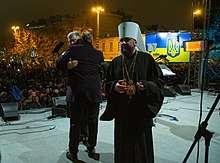
- Bulgarian Orthodox Church; autocephaly granted in 870; autocephaly re-recognized in 1235 and 1945.
- Russian Orthodox Church; autocephaly recognized in 1589.
- Church of Greece (Archdiocese of Athens and All Greece); autocephaly recognised in 1850.
- Serbian Orthodox Church; autocephaly granted in 1219; abolished in 1463 and 1766, re-recognized in 1557 and 1879.
- Romanian Orthodox Church; autocephaly recognized in 1885.
- Polish Orthodox Church (Warsaw); autocephaly recognised in 1924 by the Ecumenical Patriarchate of Constantinople and in 1948 by the Russian Orthodox Church.
- Orthodox Autocephalous Church of Albania (Archdiocese of Tirana, Durrës and All Albania); autocephaly recognised in 1937.
- Czech and Slovak Orthodox Church (Metropolis of Prague, Czech Lands and Slovakia); autocephaly recognised in 1951 by the Russian Orthodox Church and in 1998 by the Ecumenical Patriarchate of Constantinople.
- Orthodox Church of Ukraine; intention to grant autocephaly announced in 2018.[39][40][41] Rejected by the Russian Orthodox Church, the Polish Orthodox Church, and the Serbian Orthodox Church. The Ecumenical Patriarchate granted autocephaly to the Orthodox Church of Ukraine on 5 January 2019.
References
Citations
- Krindatch, Alexei (2011). Atlas of American Orthodox Christian Churches. Brookline, MA: Holy Cross Orthodox Press. p. 143. ISBN 978-1-935317-23-4.
- Panossian, Razmik (2006). The Armenians: From Kings and Priests to Merchants and Commissars. New York: Columbia University Press. pp. 43–44. ISBN 9780231139267.
The Armenian Apostolic Church formally became autocephalous—i.e. independent of external authority—in 554 by severing its links with the patriarchate of Constantinople.
- Pontificia Commissio Codici Iuris Canonici Orientalis Recognoscendo Vatican City State, 1978, p. 3 (in Latin)
- Ortaylı, İlber (2003). "Osmanlı Barışı", p. 14. ISBN 975-6571-50-0.
- In Turkey it is also referred to unofficially as Fener Rum Patrikhanesi, "Roman Patriarchate of the Phanar"
- Fairchild, Mary. "Christianity:Basics:Eastern Orthodox Church Denomination". about.com. Retrieved 22 May 2014.
- "The Patriarch Bartholomew". 60 Minutes. CBS. 20 December 2009. Retrieved 11 January 2010.
- "Biography - The Ecumenical Patriarchate". www.patriarchate.org. Retrieved 2019-12-11.
- Winfield, Nicole; Fraser, Suzan (30 November 2014). "Pope Francis Bows, Asks For Blessing From Ecumenical Patriarch Bartholomew In Extraordinary Display Of Christian Unity". Huffington Post. Archived from the original on 2016-03-17. Retrieved 2019-12-11.
- Finding Global Balance. World Bank Publications. 2005. p. 119. Retrieved 2 August 2015.
His All Holiness is the spiritual leader of 300 million Orthodox Christians worldwide
- "Who is the Ecumenical Patriarch? - Apostolic Pilgrimage of Pope Francis and Ecumenical Patriarch Bartholomew to Jerusalem". www.apostolicpilgrimage.org. Retrieved 2019-12-11.
- http://www.ecumenicalnews.com/article/pope-francis-and-ecumenical-patriarch-sign-christian-unity-declaration-27367
- Commander opposed Halki Seminary reopening over fears Archived 2011-01-22 at the Wayback Machine Today's Zaman, 21 January 2011.
- H. CON. RES. 50 United States, House of Representatives, 28 March 1995.
- Oxford Dictionary of Byzantium, p. 697
- The Patriarchate of Constantinople (The Ecumenical Patriarchate) Archived 2010-01-09 at the Wayback Machine by Ronald Roberson
- The officer given the task was killed by the crowd, and in the end the image was removed rather than destroyed: It was to be restored by Irene and removed again by Leo V: Finlay 1906, p. 111.
- A. A. Vasiliev, History of the Byzantine Empire, 1952, vol I, p. 261.
- Norwich, John J. (1967). The Normans in the South 1016-1130. p.102.
- Norwich, John J. (1992). Byzantium, The Apogee. pp.320–321.
- New Catholic Encyclopedia.
...in 1053 he [Michael Caerularius] sends off a declaration of war, then shuts up the Latin churches at Constantinople, hurls a string of wild accusations, and shows in every possible way that he wants a schism, apparently for the mere pleasure of not being in communion with the West. He got his wish. After a series of wanton aggressions, unparalleled in church history, after he had begun by striking the pope's name from his diptychs, the Roman legates excommunicated him (16 July 1054). But still there was no idea of a general excommunication of the Byzantine Church, still less of all the East. The legates carefully provided against that in their Bull. They acknowledged that the emperor (Constantine IX, who was excessively annoyed at the whole quarrel), the Senate, and the majority of the inhabitants of the city were "most pious and orthodox". They excommunicated Caerularius, Leo of Achrida, and their adherents. This quarrel, too, need no more have produced a permanent state of schism than the excommunication of any other contumacious bishop. The real tragedy is that gradually all the other Eastern patriarchs took sides with Caerularius, obeyed him by striking the pope's name from their diptychs, and chose of their own accord to share his schism. At first they do not seem to have wanted to do so. John III of Antioch certainly refused to go into schism at Caerularius's bidding. But, eventually, the habit they had acquired of looking to Constantinople for orders proved too strong. The emperor (not Constantine IX, but his successor) was on the side of his patriarch and they had learned too well to consider the emperor as their over-lord in spiritual matters too. Again, it was the usurped authority of Constantinople, the Erastianism of the East that turned a personal quarrel into a great schism.
- Bishop Kallistos (Ware), p. 67
- Gallagher, Clarence (2008). The Oxford Handbook of Byzantine Studies. Oxford University Press. p. 596. ISBN 978-0-19-925246-6.
- Vryonis, Byzantium and Europe, p. 152.
- "Archived copy". Archived from the original on 2017-05-15. Retrieved 2015-04-17.CS1 maint: archived copy as title (link)
- Jelavich, Barbara, “History of the Balkans, 18th and 19th Centuries” (1983), ISBN 0-521-27458-3 p.52
- Ortaylı, İlber (2003). "Osmanlı Barışı", p.15. ISBN 975-6571-50-0
- Константинопольская Православная Церковь (in Russian). Retrieved 18 June 2011.
- Orthodoxwiki:Ecumenical Patriarchate in America
- Turkey - Rum (Greek) Orthodox Christians Minorityrights.org
- "Konradsblatte". Konradsblatte. Retrieved 2008-09-07.
- "Ecumenical Patriarchate". www.ec-patr.org. Retrieved 2019-05-21.
- "Ecumenical Patriarchate". www.ec-patr.org. Retrieved 2019-05-24.
- Dmytro Hordiyenko. History of the Ukrainian Orthodox Church (Історія Української Православної Церкви). Glagoslav Publications.
- Mytsyk, Yu. History and Modernity of Ukrainian Orthodoxy. Ukrayinska Pravda. 25 July 2013
- Cazabonne, Emma (2019-01-15). "Decision of the Constantinople Patriarchate Holy Synod concerning the restoration of its stavropegion in Kyiv". Orthodoxie.com. Retrieved 2019-01-17.
- "Ανακοινωθέν του Οικουμενικού Πατριαρχείου για Σταυροπήγιο στο Κίεβο". ROMFEA (in Greek). 12 January 2019. Retrieved 2019-01-12.
- Panagiotisandriopoulos (2019-01-12). "Φως Φαναρίου : Η ΑΓΙΑ ΚΑΙ ΙΕΡΑ ΣΥΝΟΔΟΣ ΔΙΟΡΙΣΕ ΕΠΙΚΕΦΑΛΗΣ ΤΟΥ ΠΑΤΡΙΑΡΧΙΚΟΥ ΣΤΑΥΡΟΠΗΓΙΟΥ ΣΤΟ ΚΙΕΒΟ". Φως Φαναρίου. Retrieved 2019-01-12.
- "Ukraine hails Church independence move as ‘blow’ to Moscow", The Guardian, 12 October 2018 (Retrieved 13 October 2018)
- "Announcement of the Ecumenical Patriarchate of Constantinople". Ecumenical Patriarchate. 11 October 2018. Retrieved 12 October 2018.
1) To renew the decision already made that the Ecumenical Patriarchate proceed to the granting of Autocephaly to the Church of Ukraine.
- Tomos ante portas: a short guide to Ukrainian church independence. Euromaidan Press. 14 October 2018. Retrieved 16 October 2018.
the Synod ... of the Ecumenical Patriarchate ... gave further confirmation that Ukraine is on the path to receiving church independence from Moscow. ... Although President Poroshenko triumphantly announced that in result of the meeting Ukraine had received the long-awaited Tomos, or decree of Church independence – a claim circulated in Ukraine with great enthusiasm, this is not true. ... Constantinople’s decision will benefit other jurisdictions in Ukraine – the UOC KP and UAOC, which will have to effectively dismantle their own administrative structures and set up a new Church, which will receive the Tomos of autocephaly. ... Right now it’s unclear which part of the UOC MP will join the new Church. 10 out of 90 UOC MP bishops signed the appeal for autocephaly to the Ecumenical Patriarch – only 11%. But separate priests could join even if their bishops don’t, says Zuiev.
Sources
This article incorporates text from several articles on OrthodoxWiki:
Literature
- Kiminas, Demetrius (2009). The Ecumenical Patriarchate: A History of Its Metropolitanates with Annotated Hierarch Catalogs. Wildside Press LLC.CS1 maint: ref=harv (link)
- Kursar, Vjeran (2013). "Non-Muslim Communal Divisions and Identities in the Early Modern Ottoman Balkans and the Millet System Theory". Power and Influence in South-Eastern Europe, 16th-19th century. Berlin: LIT Verlag. pp. 97–108.CS1 maint: ref=harv (link)
- Laurent, Vitalien (1968). "Les premiers patriarches de Constantinople sous la domination turque (1454-1476): Succession et chronologie d'après un catalogue inédit". Revue des études byzantines. 26: 229–263. doi:10.3406/rebyz.1968.1407.CS1 maint: ref=harv (link)
- Meyendorff, John (1989). Imperial unity and Christian divisions: The Church 450-680 A.D. The Church in history. 2. Crestwood, NY: St. Vladimir's Seminary Press. ISBN 978-0-88-141056-3.CS1 maint: ref=harv (link)
- Meyendorff, John (1996). Rome, Constantinople, Moscow: Historical and Theological Studies. Crestwood, NY: St. Vladimir's Seminary Press.CS1 maint: ref=harv (link)
- Radojević, Mira; Mićić, Srđan B. (2015). "Serbian Orthodox Church cooperation and frictions with Ecumenical Patriarchate of Constantinople and Bulgarian Exarchate during interwar period". Studia academica šumenesia. 2: 126‒143.CS1 maint: ref=harv (link)
- Runciman, Steven (1985) [1968]. The Great Church in Captivity: A Study of the Patriarchate of Constantinople from the Eve of the Turkish Conquest to the Greek War of Independence (2nd ed.). Cambridge: Cambridge University Press.CS1 maint: ref=harv (link)
- Thomas, John P. (1987). Private Religious Foundations in the Byzantine Empire. Washington, D.C.: Dumbarton Oaks.CS1 maint: ref=harv (link)
External links
- Official website
- Patriarchs of Constantinople
- Article on the Ecumenical Patriarchate by Ronald Roberson on the website of CNEWA, a papal agency for humanitarian and pastoral support
